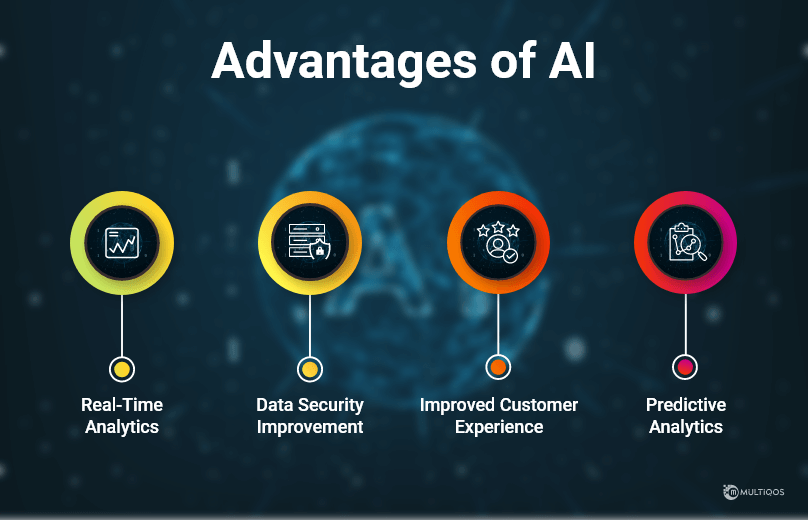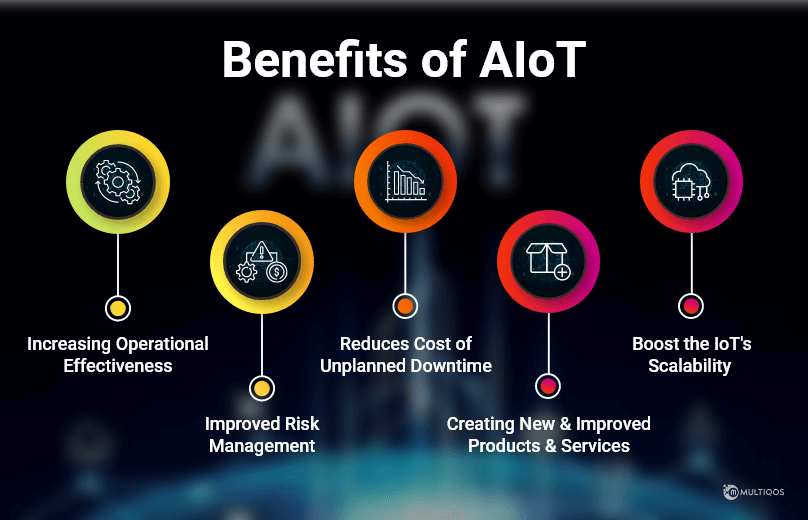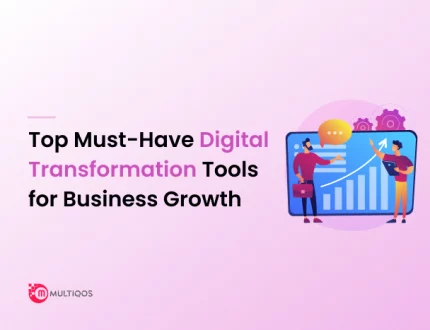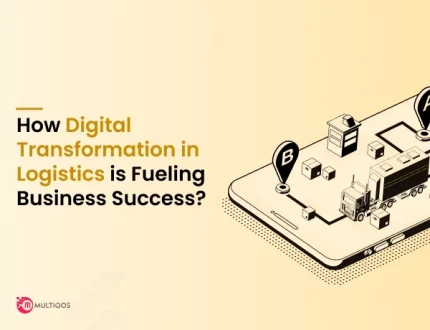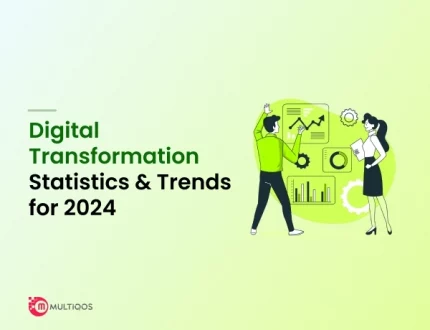IoT vs AI: Key Differences Between Internet of Things (IoT) and Artificial Intelligence (AI)
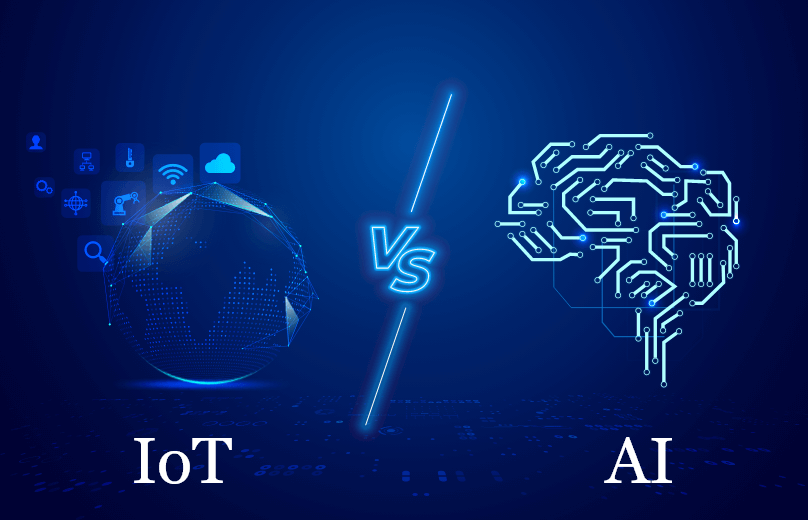
Overview
With the deployment of IoT, the business environment is changing (Internet of Things). There is a large quantity of data being collected from a variety of sources thanks to the Internet of Things (IoT). Both IoT and AI are the two phenomena of Mobile App Development that have made a name for themselves in recent years with the increasing popularity of smart technologies. While Artificial intelligence (AI) is the process of imbuing robots with intelligence and rendering them as smart and as sophisticated as humans, the concepts of the Internet of Things (IoT) involve connecting all electronic gadgets to a single, interconnected network.
What is the Internet of Things (IoT)?
IoT, or the internet of things, is a recent development in computer science. IoT can be defined as an ecosystem where electronic devices are linked to any single network through wireless connectivity and the internet. All linked devices can communicate data via integrated intelligent technology that aids in the creation of smart gadgets as well as other applications such as wearable technology, smart buildings, and smart homes.
Internet of Things functions by sending, collecting and responding to data collected from the environment utilizing inbuilt or integrated components such as CPUs, communication hardware, and detectors. Through an IoT gateway, IoT devices communicate by transferring sensor data collected by them. Furthermore, IoT Application Development aims at making the devices communicate with one another and behave in response to information acquired from other connected devices.
Advantages of IoT
- Reduced Operating Costs: A competitive advantage may be maintained while reducing costs with the use of the Internet of Things (IoT). It is used in manufacturing to monitor equipment and prevent downtime by foreseeing production line faults through the use of IoT App Development.
- Enhanced Customer Support and Retention: Companies and businesses can gather consumer-specific data and better understand their customers’ demands and behaviour through smart devices. This becomes possible because of your IoT Mobile App Developer. Organizations can improve customer care by simplifying follow-ups after purchases, including automated tracking and retaining customers.
- Analyzing Consumer Behaviour: Analyzing consumer decisions and behaviour may help organizations succeed, and IoT makes it feasible to comprehend such crucial aspects. Companies and businesses can use the Internet of Things to collect, monitor, and analyze data from various social media platforms, surveillance cameras, mobile devices, and internet activity.
- Improved Security: By incorporating IoT technology into various smart devices such as surveillance cameras, motion detectors, and other monitoring equipment, enterprises may create more secure products.
Also Read : Complete Guide: How to Develop an IoT Application
Disadvantages of IoT
- Security Flaws: Since the IoT technology collects data from various sources, it cannot provide high-level security and thus has several security flaws.
- Costs: Putting IoT infrastructure in place in a corporation entails creating an extensive network with various smart devices, a large power grid, and a communications system. As a result, there might be an increase in prices.
- Network Interdependence: A significant element of the Internet of Things is the massive number of linkages between many devices and accessibility to the global network. Such networks are interconnected, so if one fails, the others are likely to follow suit as well.
What is Artificial Intelligence (AI)?
Artificial Intelligence is one of the popular trends in computer science that primarily intends to generate and construct machines by stimulating human intelligence, resulting in smart machines that respond similarly to people. Human-like machines are the ultimate goal of artificial intelligence (AI). The goal of AI is to build machines that operate more humanely by simulating human behaviour and intelligence.
Communication, persuasion, perceiving, thinking, analyzing, learning, and responding in complicated situations are all examples of intelligent activity. AI also comprises scientific and engineering objectives. Furthermore, AI technology also contains automated industrial processes to provide more efficient and productive results. It has also made it easier for computers and machines to collaborate and work with each other effectively. Over the years, artificial intelligence is being implemented in production and marketing, sales, customer care, and research and technology.
Advantages of AI
- Real-Time Analytics: Companies can use AI to collect and analyze data and render it in real-time. One of the most significant benefits of AI for organisations is the ability to automate repetitive tasks. Because of this approach, companies are able to make swift decisions that have a significant impact on their operations.
- Data Security Improvement: One of the advantages of AI App Development is that it can effectively spot fraud attempts and unauthorized access to personal information, which is why AI is used in the banking and finance industries at an increased rate.
- Improved Customer Experience: AI-powered chatbots can provide help and service all the time and aid in addressing user requests at any moment. Organizations that communicate more frequently and respond more quickly have a better chance of keeping current customers and acquiring new ones.
- Predictive Analytics: Artificial intelligence (AI) can handle massive amounts of data, recognize trends, and forecast the results. Several businesses want to be able to foresee things to reduce risk and other issues; thus, AI is capable of all these.
Disadvantages of AI
- Increased Prices: Integrating AI into AI App Development is a time-consuming process that can also be expensive. Developing AI-integrated software programmes is likewise a challenging task.
- Lack of Creativity: This is essential to understand that AI as a technology is not creative. AI can learn over time given pre-fed bits of information and experience, but it cannot behave creatively.
Reduces efficiency of Humans: AI apps replace the majority of slow and tedious work, making humans lazy. With no need to recollect information in order to solve problems, people might become lazy and hence lose their productivity.
AI vs IoT: Know the Difference Between AI and IoT
- Definition: There are networked devices that can detect and communicate data across a network without the need for any kind of human contact, providing critical physical parameters and extra processing of that information in the cloud to provide market intelligence. The Internet of Things (IoT) is a paradigm built on the idea of ordinary physical objects being able to communicate directly through the internet. While artificial intelligence (AI) is a discipline of computer science that aspires to produce robots that can do intellectual activities as well as, if not better than, human being.
- Objectives and Goals: IoT can be considered as more of a platform that allows you to connect and interact with objects from all around the globe. IoT can be defined as the interconnection of physical devices like sensors, actuation, and other essential electronics that can connect without human intervention. Data transmission and reception via the internet are the ultimate objectives for devices. However, essentially the goal of Artificial Intelligence or AI is to make machines operate more humanely by simulating human behaviour and intelligence. The focus is to create technology that allows humans and machines to work together effectively, integrating efficiently.
- Algorithm: Because AI is all about learning, reacting, and responding like a human, it relies heavily on the careful study of algorithms obtained from various sources to include human behaviour into the system. However, the Internet of Things is working on a bespoke algorithm to alter the system’s operation.
- Data: Huge amounts of data, such as trends and patterns, as well as a comprehension of human behaviour, is required for AI. To accomplish operations such as data modelling and others, the information utilized in AI must be compiled and relevant. But, since the Internet of Things is all about collecting experiences, it relies on sensors. As a result, the more sensors there are, the more influential the data collection becomes.
- Dependability: IoT permits data to be transferred between many interconnected physical devices, and AI aids in data interpretation. Furthermore, IoT creates a massive amount of data via a vast network of interconnected devices. The vast majority of that is not even recorded, with only a small percentage losing its value within milliseconds. This necessitates a method for effectively analyzing and extracting knowledge from big data. With the help of AI tools and technology, this can be done with minimum human intervention. By employing AI approaches to conduct analytics, IoT hopes to obtain information and make projections. As a result, it can be deduced that IoT cannot function without the presence of AI.
- Costs: The cost of AI is determined by the objectives and the requirements and thus, is computed accordingly. To execute massive computations, AI necessitates highly configured network systems. As a result, leasing or renting remote servers can cost a little extra. When compared to AI, the cost of IoT is lower. It’s true that IoT requires a collection of hardware devices such as LED displays controllers, and sensors to be coupled. Portable devices, like smartphones, can also be used to operate IoT devices, lowering the expense of purchasing specialized controllers.
- Cloud Computing: AI has provided incredibly powerful cloud computing, allowing machines to learn, understand, react, and respond in similar ways to humans by constructing human instances. AI makes extensive use of cloud computing to do large computations more than a remote server called a cloud with high settings. Cloud computing is also well supported by IoT. The IoT cloud, on the other hand, provides a detailed management gateway.
Also Read: Top AI Chatbot Trends That Help Grow Your Business in 2023
When To Combine AI & IoT?
Artificial Intelligence of Things (AIoT) is a technology that enables individuals to accomplish more effective IoT operations, better human-device engagement, and improved data management and analytics. AI analytics, if effectively implemented, may transform IoT data into extremely relevant data, allowing better choices to be taken. Combining AI and IoT technology makes gadgets more powerful instruments for solving complex problems.
What is AIoT?
The Internet of Things is all about linked sensors and the data they produce. This allows you a tremendous level of freedom in day-to-day activities. Target consumers in the business and household sectors, in particular, benefit from AIoT. Despite the fact that AI and the Internet of Things are still in their developmental stage, these two technologies are currently being used in scenarios where data and problem-solving may improve results for all users.
What are the benefits of AIoT?
Proactive intervention, personalised experiences, and automation are just a few of the benefits that AI in the Internet of Things offers organisations and customers. Combining these two new technologies can bring about a wide range of business benefits, among them the following:
- Increasing Operational Effectiveness: IoT AI analyses continuous streams of data and discovers undetectable patterns by simple gauges. In addition, machine learning and AI can predict future operating conditions and indicate parameters that need to be modified in order to get the best possible outcomes.
- Improved Risk Management: Combining AI and IoT allows businesses to analyze better and predict a wide range of dangers and automate responses. As a result, they can better deal with financial loss, personnel safety, and cyber dangers.
- Reduces the Cost of Unplanned Downtime: Machine malfunction can result in expensive unplanned downtime in various industries, such as offshore oil and gas and industrial production. Proactive maintenance using AI-enabled IoT allows you to anticipate equipment malfunction and arrange routine maintenance procedures ahead of time. As a result, you can prevent the negative consequences of downtime.
- Creating New and Improved Products and Services: Combining IoT with AI may help businesses build new products or improve existing ones by handling and analyzing data more quickly.
- Boost the IoT’s Scalability: Low-cost sensors in the Internet of Things include smartphones and high-end PCs. On the other hand, the most common Internet of Things (IoT) network utilises low-cost sensors that create huge volumes of data. Before data is transferred from one device to another, an AI-powered IoT ecosystem analyses and summarises it. Consequently, it reduces massive data sets to a reasonable size and facilitates the connecting of many IoT devices.
How Does MultiQoS Help in the Creation of High-End AI and IoT Apps?
MultiQoS is the best place for all your IoT and AI-related solutions. We provide Artificial Intelligence (AI) and Internet of Things (IoT) services that provide organizations with end-to-end AI and IoT solutions while effectively blending them within their current corporate structure. AI and IoT Mobile Application Development is a specialty of our Mobile App Developer. Further, we assist you in developing creative and dependable AI and IoT apps for future technology and new opportunities. We also offer artificial intelligence and Internet of Things integration to improve efficiencies and avoid costly unplanned downtime.
Ending Word
The distinction between the concepts of the Internet of Things and Artificial Intelligence has narrowed down with the passage of time and the development of more advanced technologies; however, the distinction still prevails. Consequently, the Internet of Things (IoT) is a vast network of internet-connected computer gadgets. These devices can sense, accumulate, and transmit data via a network without any need for human intervention. However, the concept and functions of AI can be associated with building smart, machine intelligence that can respond and interact like people, with sensory, actuation, storage systems, and processing capabilities, which your iOS or Android App Developer can accomplish.
Let’s Create Big Stories Together
Mobile is in our nerves. We don’t just build apps, we create brand. Choosing us will be your best decision.
Frequently Asked Questions on Internet of Things (IoT) Vs Artificial Intelligence(AI)
Many well-established businesses are pouring money into AI and IoT technology to improve their operations. These technologies are used by well-known companies like Google, Amazon, and Netflix.
Both IoT and AI have significant contributions towards Mobile Application Development. They are being used in a plethora of areas such as automated cutting machines, personal assistants in our smartphones, or PCs, Self-driving cars, or smart devices such as Alexa or Siri.
Generally, your dedicated development team should be well versed with the programming languages of Java, Python, Golang, and C.
Get In Touch

